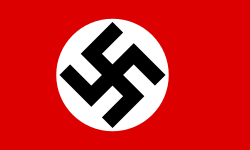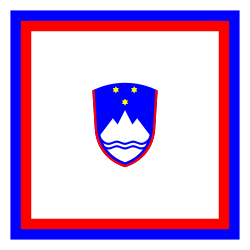| Flag | Date | Use | Description |
|---|
 | 800-888 | Imperial Orilflamme of Charlemagne | A green 3 pointed field with 8 golden crosses and 6 flowers. |
 | 907–962 | Flag of the Principality of Hungary | A red swallow-tailed flag. [16] [17] |
 | 962–1401 | Banner of the Emperor of the Romans and of the King of Germany | A black eagle on a yellow field |
 | 1077–1420 | Flag of The Patriarchate of Aquileia | A golden eagle on a blue field |
 | 1102–1172 | Flag of the Kingdom of Hungary | A red flag with a white Latin cross in the center. |
 | 1172–1196 | A red flag with a white patriarchal cross in the center. |
 | 1196–1301 | A red flag with a white patriarchal cross on a green triple mount in the center. |
 | Flag of the Árpád dynasty | Eight horizontal stripes alternating red and white. |
 | 1301–1382 | Flag of the Kingdom of Hungary | Eight horizontal stripes alternating red and white with a yellow fleur-de-lis pattern on a vertical blue stripe at the hoist. |
 | 1387–1437 | A red flag divided into four quarters: eight horizontal stripes alternating white and red in the first and fourth quarters, a white eagle in the second quarter and a white lion in the third quarter. |
 | 1401–1430 | Imperial Banner of the Holy Roman Emperor and Flag of The Holy Roman Empire | An Imperial Eagle displayed with a halo sable armed and langued gules. |
 | 1420–1797 | Flag of The Republic of Venice | A gold Lion of St. Mark on a field of dark red accompanied by six sestiere on the fly. [18] |
 | 1430–1804 | Imperial Banner of the Holy Roman Emperor and Flag of The Holy Roman Empire | A black double-headed eagle with haloes on a yellow field. |
 | 1440–1444 | Flag of the Kingdom of Hungary | A red flag divided into four quarters: eight horizontal stripes alternating white and red in the first and fourth quarters and a white eagle in the second and third quarters. |
 | 1458–1490 | A red swallow-tailed flag divided into four quarters: eight horizontal stripes alternating white and red in the first and fourth quarters, a white patriarchal cross on a green triple mount in the second quarter, a white lion in the third quarter and the coat of arms of the Hunyadi family in the center. |
 | A red swallow-tailed flag divided into four quarters: eight horizontal stripes alternating white and red in the first quarter, a white patriarchal cross on a green triple mount in the second quarter, three crowned golden leopards' heads on a blue field in the third quarter, a white lion in the fourth quarter and the coat of arms of the Hunyadi family in the center. |
 | 1490–1516 | A red swallow-tailed flag divided into four quarters: eight horizontal stripes alternating red and white in the first and fourth quarters and a white patriarchal cross on a green triple mount in the second and third quarters. |
 | 1516–1526 | A red swallow-tailed flag divided into four quarters: eight horizontal stripes alternating red and white in the first quarter, a white patriarchal cross on a green triple mount in the second quarter, three crowned golden leopards' heads on a blue field in the third quarter, a white lion in the fourth quarter and a white eagle on a red escutcheon in the center. |
 | 1754–1815 | Flag of the Princely County of Gorizia and Gradisca | A horizontal bicolour of white and red. |
 | 1804–1918 | Flag of the Habsburg monarchy and also the flag of the Austrian Empire. Sometimes used as the unofficial national flag of Austria-Hungary. | A horizontal bicolour of black and yellow. |
 | 1809–1813 | Flag of the First French Empire | A vertical tricolour of blue, white, and red (proportions 3:2). |
 | Flag of the Napoleonic Italy | A composition formed by a green rectangle inserted in a white diamond, in turn included in a red box, with an imperial eagle in the center. |
 | 1815–1866 | Flag of the German Confederation | A tricolour, made of three equal horizontal bands coloured black (top), red, and gold (bottom). |
 | 1815–1816 | Flag of The Kingdom of Lombardy–Venetia | A Yellow Field bordered with black triangles and with the Austrian Eagle in the center. [19] |
 | 1816–1848 | Flag of The Kingdom of Illyria | A horizontal bicolour of white and red with the Austrian eagle in the center. [20] |
 | 1848–1918 | Flag of The Duchy of Carniola | A horizontal tricolour of white, blue and red. |
 | 1849 | Flag of The Hungarian State | A horizontal tricolor of red, white, and green with the state coat of arms in the center. |
 | 1849–1918 | Flag of The Austrian Littoral | a horizontal tricolour of yellow, red, and blue with the coat of arms in the center. |
 | 1850–1918 | Flag of The Imperial Free City of Trieste | A horizontal tricolour of red (top), white, and red with a golden spear in the center. |
 | 1869–1918 | Merchant Flag of Austria-Hungary | A horizontal triband of red, white and red / green with the Austrian escutcheon on the hoist side and the crowned small coat of arms of Hungary on the fly side. [21] [22] |
 | 1869–1874 | Flag of the Kingdom of Hungary | A horizontal tricolor of red, white and green with the crowned small coat of arms in the center. [23] |
 | 1874–1896 |
 | 1896–1915 | A horizontal tricolor of red, white and green with the crowned small coat of arms flanked by two angels in the center. |
 | Civil Flag of the Kingdom of Hungary | A horizontal tricolor of red, white and green with the combined coat of arms of the Lands of the Holy Hungarian Crown in the center. |
 | 1915–1918
1941–1944 | Flag of the Kingdom of Hungary | A horizontal tricolor of red, white and green with the crowned small coat of arms in the center. |
 | 1915–1918 | Civil Flag of the Kingdom of Hungary | A horizontal tricolor of red, white and green with the combined coat of arms of the Lands of the Holy Hungarian Crown in the center. |
 | 1918 | Flag of The State of Slovenes, Croats and Serbs | A horizontal tricolour of red, white and blue. |
 | 1918–1941 | Flag of The Kingdom of Yugoslavia | Three equal horizontal bands in the pan-Slavic colors, blue (top), white, and red. |
 | 1941–1943
1945–1947 | Flag of The Kingdom of Italy | An Italian tricolour with Savoy shield and Royal crown in the middle. [24] |
 | 1941–1945 | Flag of The Independent State of Croatia | A tricolour of red, white, and blue with the Ustaše symbol in top-left corner (letter "U" surrounded by Croatian interlace) and the Croatian coat of arms (but with the first field white, as opposed to red) in the center. The flag used Ustaše colors, proportions 2:3. |
 | Flag of Nazi Germany | A red field, with a white disc with a black swastika at a 45-degree angle. Disk and swastika are slightly off-centre. [25] [26] |
 | 1941–1946 | Flag of The Slovene Partisans | Three equal horizontal bands, white (top), blue, and red, with a red star in the central white band. |
 | 1945–1946 | Flag of The Democratic Federal Yugoslavia | Three equal horizontal bands in the pan-Slavic colors, blue (top), white, and red, with a red star in the central white band. [27] |
 | 1946–1991 | Flag of The Socialist Federal Republic of Yugoslavia | Three equal horizontal bands in the pan-Slavic colors, blue (top), white, and red, with a yellow-bordered red star at the flag's center. [28] [29] [30] |
 | Flag of The Socialist Republic of Slovenia | Three equal horizontal bands, white (top), blue, and red, with a yellow-bordered red star at the flag's center. [31] |
 | 1947–1954 | Flag of The Free Territory of Trieste | A red field with a white spear in the center. |





























































